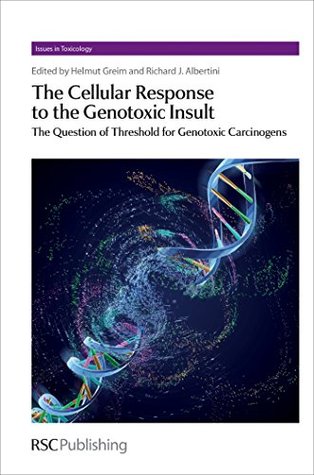Read Online The Cellular Response to the Genotoxic Insult: The Question of Threshold for Genotoxic Carcinogens (Issues in Toxicology) - Helmut Greim file in PDF
Related searches:
Cellular response to the genotoxic insult: the question of threshold
The Cellular Response to the Genotoxic Insult: The Question of Threshold for Genotoxic Carcinogens (Issues in Toxicology)
The Cellular Response To The Genotoxic Insult The - NACFE
The ATM protein kinase: regulating the cellular response - PubMed
The ATM protein kinase: regulating the cellular response to - Nature
Protein kinases and their involvement in the cellular responses to
The Cellular Response to the Genotoxic Insult (RSC Publishing)
Issues in Toxicology: The Cellular Response to the Genotoxic
Signaling mechanisms involved in the response to genotoxic
Cell and tissue responses to genotoxic stress - Coates - 2005 - The
The yeast mitogen-activated protein kinase Slt2 is involved in the
Participation of p53 Protein in the Cellular Response to DNA Damage
The Cellular Response to the Genotoxic Insult 1st edition
The Cellular Response to the Genotoxic Insult PDF
The Cellular Response to the Genotoxic Insult - Helmut Greim
Greim, H: Cellular Response to the Genotoxic Insult: The
[Offer PDF] Cellular Response to the Genotoxic Insult : The
The cellular response to the genotoxic insult the question of threshold for genotoxic carcinogens 1st edition by mathieu vinken and publisher royal society of chemistry. Save up to 80% by choosing the etextbook option for isbn: 9781849732925, 1849732922. The print version of this textbook is isbn: 9781849731775, 1849731772.
10 jan 2005 growth arrest or apoptosis? the role of p53 family members in damage responses; indirect effects of dna‐damaging agents; genetic factors.
Review: gene amplification--a cellular response to genotoxic stress.
Genotoxic carcinogens can lead to dna mutations with the potential to cause cancer. Typically, a series of mutation events are needed before malignancy occurs so a single, small exposure may not result in disease. Also, cells have an armoury of defence mechanisms which, to a degree, counter the effects of mutagens. Distinguishing the point at which exposure to a carcinogen increases mutation.
Furthermore, two of their phase i metabolites identified by metabolism studies employing liver microsomes were examined regarding their genotoxic potential. Lastly, the associated dna damage signaling pathways induced as a cellular response to potential genotoxic events were addressed.
13 mar 2013 is a far more versatile kinase, with roles in cell responses to other genotoxic which are involved in the cellular response to genotoxic stress.
Furthermore, slt2 was activated by all these treatments, which suggests that slt2 plays a central role in the cellular response to genotoxic stresses.
[offer pdf] cellular response to the genotoxic insult� the question of threshold for genotoxic carcinogenseditor(s): helmut greim,richard albertini publica�[offer pdf] cellular response to the genotoxic insult� the question of threshol,© 博学网 (boxue58/boxuesky).
In general, the cellular genotoxic response can be thought to occur in three stages: (1) damage sensing; (2) activation of signal transduction pathways;.
To maintain the integrity of the genome, a cell challenged with genotoxic stress must sense the damage and respond to it by stalling cell cycle progression until the damage is repaired. If the damage is catastrophic, then pro-apoptotic mechanisms are activated, resulting in cell death.
The atm protein kinase: regulating the cellular response to genotoxic stress, and more.
2020年6月8日 the present study gives deeper insights into the genotoxic effects of asarone isomers as well as their known oxidative phase i metabolites, (e)-3'-.
In this paper, molecules which are able to induce oxidative stress and/or dna damage have been selected and their toxic and genotoxic effects on the u937 cell.
Of large transcriptional programs: the cellular response to genotoxic stress. The responses to ionizing radiation and other genotoxic environmental stresses.
The human genome is exposed to potentially deleterious genotoxic events during every cell division cycle.
The cellular response to the genotoxic impact key events beyond these first two in the moa for tumours produced by genotoxic carcinogens involve the induction of mutations. 17 even here however, when cells must deal with dna damage, there are mechanisms that strongly suggest non-linearity of the dose response curves.
In this book the different cellular defence mechanisms and their regulation are described. Understanding the protective mechanisms by which the cell responds to a genotoxic impact to protect integrity of the genomes will permit the evaluation of whether the assumption of a threshold for genotoxic carcinogens at low dose exposure is justified.
This implies that, at very low doses, the mutation rate induced by a genotoxic carcinogen becomes indistinguishable from the background mutation frequency. Moreover, the array of cellular defence mechanisms to a genotoxic insult makes it unlikely that a single event overcomes these barriers to cancer.
8 jan 2010 abstract: the circadian clock is an evolutionarily conserved time-keeping system that coordinates the physiology of the organism with daily.
The cellular response to the genotoxic insult genotoxic carcinogens can lead to dna mutations with the potential to cause cancer. Typically, a series of mutation events are needed before malignancy occurs so a single, small exposure may not result in disease.

Post Your Comments: